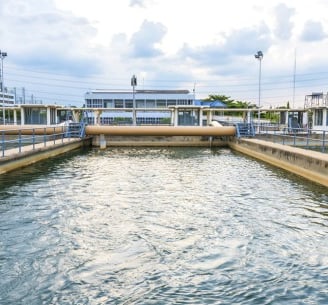Polymer Dosing and Sand Filtration: Achieving Turbidity Below 0.2 NTU with Jar Testing
Turbidity in water, caused by suspended particles like clay, silt, or organic matter, is a critical parameter in water treatment, affecting both aesthetics and safety. Achieving ultra-low turbidity levels (<0.2 NTU) is essential for applications like potable water production, industrial processes, or high-purity systems. Polymer dosing prior to sand filtration is a highly effective method to enhance particle removal and consistently achieve such low turbidity levels. This article explores how these processes work together, the role of jar testing in optimizing polymer dosing, and how to adjust dosing under varying water quality scenarios.
WATER PURIFICATIONMECHANICAL
5/31/20255 min read


How Polymer Dosing Enhances Sand Filtration
Polymer Dosing
Polymer dosing involves adding synthetic or natural polymers—typically cationic, anionic, or non-ionic polyelectrolytes—to water before filtration. These polymers function as coagulants or flocculants, aiding in the aggregation of fine suspended particles into larger, more easily filterable flocs.
Mechanism: Polymers work by neutralizing particle charges (coagulation) or bridging particles together (flocculation). Cationic polymers are effective for negatively charged particles like clay, while anionic polymers suit positively charged particles or organic matter. Non-ionic polymers are versatile for less specific applications.
Purpose: By forming larger flocs, polymers increase the efficiency of downstream filtration, reducing the load on filters and improving turbidity removal.
Sand Filtration
Sand filtration removes suspended solids by passing water through a bed of sand or other granular media. The sand traps flocs and particles through physical straining, adsorption, and interception.
Role in Turbidity Reduction: Sand filters excel at removing larger particles but struggle with fine colloids (<1 µm) that contribute to turbidity. Polymer dosing addresses this by aggregating fine particles into larger flocs, which the sand filter can then capture more effectively.
Outcome: Properly dosed polymers ensure that sand filters can reduce turbidity to <0.2 NTU by enhancing particle capture and minimizing filter breakthrough.
The combination of polymer dosing and sand filtration is synergistic:
Polymer Pre-Treatment: Increases floc size, making particles easier to trap in the sand bed.
Sand Filtration: Removes the flocs formed by polymers, along with residual suspended solids, achieving ultra-low turbidity.
Backwashing Efficiency: Larger flocs are less likely to penetrate deep into the filter bed, making backwashing more effective and extending filter run times.
This combination consistently achieves turbidity levels below 0.2 NTU, meeting stringent standards like those for drinking water (e.g., WHO guidelines recommend <1 NTU, ideally <0.2 NTU for disinfection efficiency).
Jar Testing for Polymer Dose Optimization
Jar testing is a laboratory procedure used to simulate coagulation, flocculation, and sedimentation processes, allowing operators to determine the optimal polymer type and dose rate for specific water quality conditions. It’s critical for tailoring dosing to achieve <0.2 NTU turbidity while minimizing polymer overuse, which can increase costs or cause filter fouling.
Jar Testing Procedure
Sample Collection: Collect representative water samples from the source (e.g., river, reservoir, or process water).
Setup: Fill six or more 1-liter jars with the water sample. Use a jar test apparatus with variable-speed stirrers.
Polymer Selection: Choose a polymer (e.g., cationic polyacrylamide for high clay content, anionic for organic-rich water). Prepare stock solutions (e.g., 0.1% w/v) for accurate dosing.
Dosing: Add increasing polymer doses (e.g., 0, 0.5, 1, 2, 5, 10 mg/L) to each jar while stirring rapidly (100–200 rpm) for 1–2 minutes to simulate coagulant mixing.
Flocculation: Reduce stirring speed to 20–40 rpm for 10–15 minutes to promote floc formation.
Settling: Stop stirring and allow flocs to settle for 10–20 minutes. Observe floc size, settling rate, and supernatant clarity.
Turbidity Measurement: Measure the turbidity of the supernatant in each jar using a calibrated turbidimeter.
Analysis: Select the dose that achieves turbidity <0.2 NTU with the smallest polymer amount, ensuring cost-effectiveness and minimal residual polymer.
Key Observations
Floc Characteristics: Effective doses produce large, settleable flocs. Weak or no flocs indicate under-dosing; sticky or cloudy water suggests over-dosing.
Turbidity: The optimal dose minimizes turbidity while avoiding excessive polymer, which can increase turbidity or clog filters.
Mixing and Settling: Adjust mixing intensity and time based on floc formation to mimic plant conditions.
Adjusting Polymer Dosing for Different Water Quality Scenarios
Water quality varies due to factors like seasonal changes, rainfall, or industrial inputs, requiring tailored polymer dosing. Below are common scenarios and jar testing considerations:
1. High Turbidity, Clay-Dominant Water (e.g., >50 NTU, River Water After Rain)
Characteristics: High suspended solids, often negatively charged clay particles.
Polymer Choice: Cationic polymers (e.g., polyDADMAC) are effective due to charge neutralization.
Jar Testing:
Test higher doses (e.g., 2–20 mg/L) due to increased particle load.
Use rapid mixing (150–200 rpm) to ensure polymer-particle interaction.
Look for fast-forming, dense flocs that settle quickly.
Outcome: A dose of 5–10 mg/L often achieves <0.2 NTU post-filtration, as clay particles flocculate readily with cationic polymers.
Plant Adjustment: Increase dosing during high-turbidity events and monitor filter backwash frequency to prevent clogging.
2. Low Turbidity, Organic-Rich Water (e.g., 5–10 NTU, Lake Water)
Characteristics: High organic content (e.g., algae, humic acids), often with negatively charged particles.
Polymer Choice: Anionic or non-ionic polymers (e.g., anionic polyacrylamide) work well for organic matter.
Jar Testing:
Test lower doses (e.g., 0.5–5 mg/L) since fewer particles require less polymer.
Use gentler mixing (100–150 rpm) to avoid breaking fragile organic flocs.
Check for clear supernatant and minimal residual polymer.
Outcome: Doses of 1–3 mg/L typically suffice, as organic particles are lighter and easier to flocculate.
Plant Adjustment: Reduce dosing to avoid over-flocculation, which can increase turbidity or foul filters.
3. Variable Turbidity, Industrial Process Water (e.g., 10–100 NTU)
Characteristics: Inconsistent particle types (e.g., minerals, oils, or chemicals) due to process variability.
Polymer Choice: A blend of cationic and anionic polymers or a non-ionic polymer may be needed for versatility.
Jar Testing:
Test a wide dose range (e.g., 1–15 mg/L) and multiple polymer types.
Simulate plant conditions closely, including pH adjustments if needed (e.g., pH 6–8 optimizes most polymers).
Monitor for floc stability under varying conditions.
Outcome: Doses vary widely (2–10 mg/L), depending on particle composition. Jar testing ensures flexibility.
Plant Adjustment: Automate dosing with real-time turbidity monitoring to adapt to fluctuations.
4. Low Turbidity, Colloidal Particles (e.g., <5 NTU, Groundwater)
Characteristics: Fine colloids that resist settling, contributing to persistent turbidity.
Polymer Choice: Cationic polymers or coagulant aids (e.g., alum + polymer) enhance colloid aggregation.
Jar Testing:
Test very low doses (e.g., 0.1–2 mg/L) to avoid over-dosing, which can destabilize flocs.
Extend flocculation time (15–20 minutes) to allow small flocs to form.
Measure turbidity precisely, as small changes are critical at low NTU levels.
Outcome: Doses as low as 0.5–1 mg/L can achieve <0.2 NTU, as colloids require minimal polymer for aggregation.
Plant Adjustment: Use precise dosing pumps and frequent jar testing to maintain ultra-low turbidity.
Practical Considerations for Implementation
Polymer Selection: Work with suppliers to test multiple polymers. Match polymer charge and molecular weight to water characteristics.
pH Adjustment: Polymers perform best within specific pH ranges (typically 6–8). Adjust pH during jar testing if needed.
Filter Maintenance: Ensure sand filters are properly maintained (e.g., regular backwashing, media inspection) to complement polymer dosing.
Monitoring: Install online turbidimeters post-filtration to verify <0.2 NTU and adjust dosing in real-time.
Cost Management: Optimize dosing through jar testing to minimize polymer use while meeting turbidity goals.
Polymer dosing prior to sand filtration is a powerful strategy for achieving turbidity below 0.2 NTU, critical for high-quality water production. Polymers enhance floc formation, allowing sand filters to efficiently remove particles, even in challenging water quality conditions. Jar testing is indispensable for determining the optimal polymer type and dose, tailored to specific scenarios like high clay content, organic-rich water, or variable industrial inputs. By systematically applying jar testing and adjusting dosing based on water quality, operators can ensure consistent performance, cost-efficiency, and compliance with stringent turbidity standards. Regular monitoring and maintenance further enhance the reliability of this approach, making it a cornerstone of modern water treatment.
